
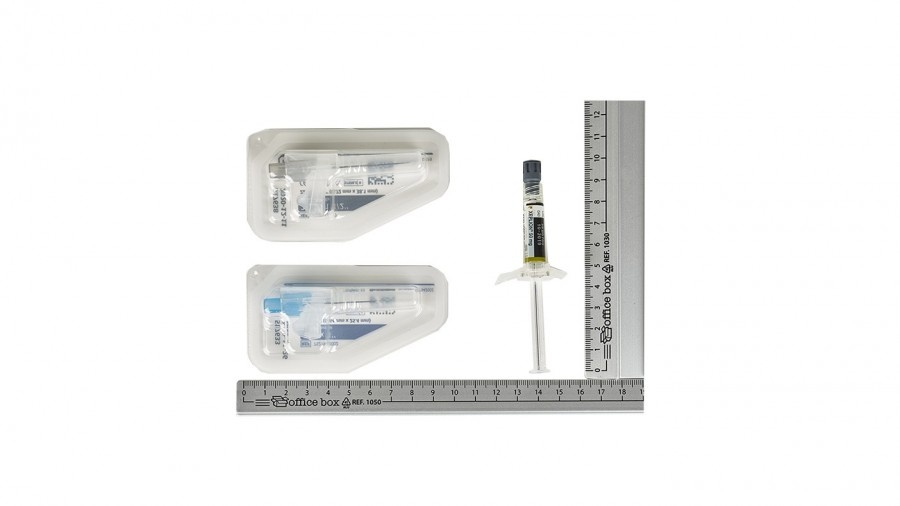
ПАЛЬМЕУКС 50 мг СУСПЕНЗИЯ ДЛЯ ИНЪЕКЦИЙ ПРОЛОНГИРОВАННОГО ДЕЙСТВИЯ В ПРЕДНАПОЛНЕННОМ ШПРИЦЕ


Инструкция по применению ПАЛЬМЕУКС 50 мг СУСПЕНЗИЯ ДЛЯ ИНЪЕКЦИЙ ПРОЛОНГИРОВАННОГО ДЕЙСТВИЯ В ПРЕДНАПОЛНЕННОМ ШПРИЦЕ
Введение
Прошу: информация для пользователя
Палмеукс 25мг суспензия для инъекцийс длительным высвобождением в предварительно заполненном шприце EFG
Палмеукс 50мг суспензия для инъекций с длительным высвобождением в предварительно заполненном шприце EFG
Палмеукс 75мг суспензия для инъекций с длительным высвобождением в предварительно заполненном шприце EFG
Палмеукс 100мг суспензия для инъекций с длительным высвобождением в предварительно заполненном шприце EFG
Палмеукс 150мг суспензия для инъекций с длительным высвобождением в предварительно заполненном шприце EFG
Палиперидон
Прочитайте внимательно весь листок инструкции перед началом использования этого лекарства, поскольку он содержит важную информацию для вас.
- Сохраните этот листок инструкции, поскольку вам может потребоваться прочитать его снова.
- Если у вас есть какие-либо вопросы, проконсультируйтесь с вашим врачом, фармацевтом или медсестрой.
- Если вы испытываете побочные эффекты, проконсультируйтесь с вашим врачом, фармацевтом или медсестрой, даже если это побочные эффекты, которые не указаны в этом листке инструкции. См. раздел 4.
Содержание листка инструкции
- Что такое Палмеукс и для чего он используется
- Что вам нужно знать перед началом использования Палмеукса
- Как использовать Палмеукс
- Возможные побочные эффекты
- Хранение Палмеукса
- Содержание упаковки и дополнительная информация
1. Что такое Палмеукс и для чего он используется
Это лекарство содержит активное вещество палиперидон, которое принадлежит к классу антипсихотических лекарств и используется в качестве поддерживающего лечения симптомов шизофрении у взрослых пациентов, стабилизированных палиперидоном или рисперидоном.
Если вы ранее реагировали на палиперидон или рисперидон и имеете легкие или умеренные симптомы, ваш врач может начать лечение Палмеуксом без предварительной стабилизации палиперидоном или рисперидоном.
Шизофрения - это расстройство с «позитивными» и «негативными» симптомами. Позитивный означает избыток симптомов, которые обычно не присутствуют. Например, человек с шизофренией может слышать голоса или видеть вещи, которые не существуют (галлюцинации), иметь неправильные убеждения (бред) или иметь чрезмерную подозрительность к другим. Негативный относится к отсутствию поведения или эмоций, которые обычно присутствуют. Например, человек с шизофренией может стать замкнутым и не реагировать на какие-либо эмоциональные стимулы или могут иметь проблемы с ясной и логической речью. Люди, страдающие этим расстройством, также могут чувствовать себя депрессивными, тревожными, виноватыми или напряженными.
Это лекарство может помочь облегчить симптомы вашего заболевания и предотвратить их повторение.
2. Что вам нужно знать перед началом использования Палмеукса
Не используйте Палмеукс:
- если вы аллергичны к палиперидону или любому другому компоненту этого лекарства (перечисленному в разделе 6).
- если вы аллергичны к любому другому антипсихотическому лекарству, включая рисперидон.
Предостережения и меры предосторожности
Проконсультируйтесь с вашим врачом, фармацевтом или медсестрой перед началом использования Палмеукса.
Это лекарство не было изучено у пациентов пожилого возраста с деменцией. Однако пациенты пожилого возраста с деменцией, которые лечатся другими подобными лекарствами, могут иметь повышенный риск инсульта или смерти (см. раздел 4, возможные побочные эффекты).
Все лекарства имеют побочные эффекты, и некоторые из побочных эффектов этого лекарства могут ухудшить симптомы других заболеваний. Поэтому важно обсудить с вашим врачом любое из следующих заболеваний, которые могут ухудшиться во время лечения этим лекарством:
- если у вас есть болезнь Паркинсона
- если вам когда-либо был поставлен диагноз заболевания, симптомы которого включают повышенную температуру и мышечную ригидность (также известное как злокачественный нейролептический синдром)
- если у вас когда-либо были аномальные движения языка или лица (тардивная дискинезия)
- если у вас были низкие уровни белых кровяных клеток (которые могут быть вызваны другими лекарствами)
- если вы диабетик или имеете склонность к диабету
- если у вас был рак молочной железы или опухоль гипофиза
- если у вас есть сердечно-сосудистое заболевание или если вы получаете лечение сердечно-сосудистых заболеваний, которые могут сделать вас более склонным к снижению артериального давления
- если у вас низкое артериальное давление при стоянии или внезапном подъеме
- если у вас есть эпилепсия
- если у вас есть проблемы с почками
- если у вас есть проблемы с печенью
- если у вас есть длительная и болезненная эрекция
- если у вас есть трудности с контролем температуры тела или если вы перегреты
- если у вас высокий уровень пролактина в крови или если у вас опухоль, зависимая от пролактина
- если у вас или у членов вашей семьи есть истории тромбозов, поскольку антипсихотические лекарства связаны с образованием тромбов.
Если у вас есть одно из этих заболеваний, пожалуйста, проконсультируйтесь с вашим врачом, поскольку может потребоваться коррекция дозы или наблюдение в течение некоторого времени.
Поскольку в очень редких случаях у пациентов, лечившихся этим лекарством, наблюдался опасно низкий уровень определенного типа белых кровяных клеток, необходимых для борьбы с инфекциями в крови, ваш врач может проверить уровень белых кровяных клеток.
Даже если вы ранее переносили палиперидон или рисперидон, редко могут возникать аллергические реакции после введения Палмеукса. Обратитесь за медицинской помощью немедленно, если вы испытываете кожную сыпь, отек горла, зуд или проблемы с дыханием, поскольку это могут быть признаки тяжелой аллергической реакции.
Это лекарство может вызвать увеличение веса. Значительное увеличение веса может негативно повлиять на ваше здоровье. Ваш врач будет регулярно контролировать ваш вес.
У пациентов, лечившихся этим лекарством, наблюдался сахарный диабет или ухудшение существующего сахарного диабета, ваш врач должен проверить признаки повышения сахара в крови. У пациентов с существующим сахарным диабетом необходимо регулярно контролировать уровень сахара в крови.
Поскольку это лекарство может уменьшить рвотный рефлекс, существует возможность того, что оно может маскировать нормальную реакцию организма на прием токсичных веществ или других заболеваний.
Во время операции на глазах по поводу катаракты зрачок (черный круг в центре глаза) может не расшириться так, как необходимо. Кроме того, радужная оболочка (цветная часть глаза) может стать вялой во время операции, что может вызвать повреждение глаза. Если вы планируете операцию на глазах, убедитесь, что вы сообщите офтальмологу, что используете это лекарство.
Дети и подростки
Не используйте это лекарство у детей до 18 лет.
Другие лекарства и Палмеукс
Сообщите вашему врачу, если вы используете, недавно использовали или можете использовать любое другое лекарство.
Прием этого лекарства вместе с карбамазепином (антиэпилептическим и стабилизирующим настроение) может потребовать коррекции дозы этого лекарства.
Поскольку это лекарство действует в основном на мозг, взаимодействие с другими лекарствами, которые также действуют на мозг, может вызвать усиление побочных эффектов, таких как сонливость или другие эффекты на мозг, такие как другие психиатрические лекарства, опиоиды, антигистаминные препараты и снотворные.
Поскольку это лекарство может уменьшить артериальное давление, вам следует быть осторожным, если вы используете это лекарство с другими лекарствами, которые также уменьшают артериальное давление.
Это лекарство может уменьшить эффективность лекарств от болезни Паркинсона и синдрома беспокойных ног (например, леводопы).
Это лекарство может вызвать аномалию на электрокардиограмме (ЭКГ), которая указывает на то, что необходимо более длительный период для прохождения электрического импульса через определенную часть сердца (известную как «пролонгация интервала QT»). Другие лекарства, которые имеют этот эффект, включают некоторые лекарства, используемые для лечения сердечного ритма или инфекций, а также другие антипсихотические лекарства.
Если вы склонны к судорогам, это лекарство может увеличить вероятность их возникновения. Другие лекарства, которые имеют этот эффект, включают некоторые лекарства, используемые для лечения депрессии или инфекций, а также другие антипсихотические лекарства.
Палмеукс следует использовать с осторожностью с лекарствами, которые увеличивают активность центральной нервной системы (психостимуляторами, такими как метилфенидат).
Палмеукс и алкоголь
Необходимо избегать алкоголя.
Беременность и лактация
Если вы беременны или кормите грудью, считаете, что можете быть беременной или планируете стать беременной, проконсультируйтесь с вашим врачом или фармацевтом перед использованием этого лекарства. Не следует использовать это лекарство во время беременности, если только это не обсуждалось с вашим врачом. У новорожденных детей матерей, лечившихся палиперидоном в последнем триместре беременности (последние три месяца беременности), могут возникнуть следующие симптомы: тремор, ригидность и/или мышечная слабость, сонливость, агитация, проблемы с дыханием и трудности с кормлением. Если ваш ребенок развивает любой из этих симптомов, необходимо обратиться к врачу.
Это лекарство может проникать в грудное молоко и наносить вред ребенку. Следовательно, не следует кормить грудью во время использования этого лекарства.
Вождение и использование машин
Во время лечения этим лекарством могут возникать головокружения, сильная усталость и проблемы с зрением (см. раздел 4). Это должно быть принято во внимание при необходимости максимальной бдительности, например, при вождении или работе с машинами.
Палмеукс содержит натрий
Это лекарство содержит менее 1 ммоль натрия (23 мг) на дозу; это означает, что оно практически «не содержит натрия».
.
3. Как использовать Палмеукс.
Ваш врач или другой медицинский работник введет это лекарство. Ваш врач укажет, когда необходимо ввести следующую инъекцию. Важно не пропускать ни одной из запланированных доз. Если вы не можете посетить врача, обязательно позвоните ему немедленно, чтобы назначить другое время как можно скорее.
Вы получите первую инъекцию (150 мг) и вторую инъекцию (100 мг) этого лекарства в верхнюю часть руки примерно с недельным интервалом. После этого вы будете получать инъекцию (от 25 мг до 150 мг) в верхнюю часть руки или в ягодицы один раз в месяц.
Если ваш врач меняет вас с рисперидона длительного действия на это лекарство, вы получите первую инъекцию этого лекарства (от 25 мг до 150 мг) в верхнюю часть руки или в ягодицы на следующую запланированную инъекцию. После этого вы будете получать инъекцию (от 25 мг до 150 мг) в верхнюю часть руки или в ягодицы один раз в месяц.
В зависимости от ваших симптомов врач может увеличить или уменьшить количество лекарства, которое вы получаете, на уровне дозы во время запланированной ежемесячной инъекции.
Пациенты с проблемами почек
Ваш врач может скорректировать дозу этого лекарства в соответствии с функцией почек. Если у вас легкие проблемы с почками, ваш врач может назначить меньшую дозу. Не следует использовать это лекарство, если у вас умеренные или тяжелые проблемы с почками.
Пациенты пожилого возраста
Ваш врач может уменьшить дозу этого лекарства, если функция почек снижена.
Если вы получите больше Палмеукса, чем необходимо
Вы будете получать это лекарство под медицинским наблюдением; поэтому маловероятно, что вы получите чрезмерную дозу.
Пациенты, получившие чрезмерную дозу палиперидона, могут испытывать следующие симптомы: сонливость или седация, учащенное сердцебиение, низкое артериальное давление, аномалии на электрокардиограмме (ЭКГ) или медленные или аномальные движения лица, тела, рук или ног.
В случае передозировки или случайного приема обратитесь за медицинской помощью немедленно или позвоните в Центр токсикологической информации, телефон 91 562 04 20, указав лекарство и количество, принятое перорально.
Если вы прекратите лечение Палмеуксом
Если вы перестанете получать инъекции, вы потеряете эффект от лекарства. Не следует прекращать использование этого лекарства, если только это не указано вашим врачом, поскольку симптомы могут возобновиться.
Если у вас есть какие-либо другие вопросы об использовании этого лекарства, обратитесь к вашему врачу или фармацевту.
4. Возможные побочные эффекты
Как и все лекарства, это лекарство может вызывать побочные эффекты, хотя не все люди испытывают их.
Немедленно сообщите врачу, если:
- у вас образуются тромбы в венах, особенно в ногах (симптомы включают отек, боль и покраснение ноги), которые могут распространиться через кровеносные сосуды в легкие, вызывая боль в груди и затруднение дыхания. Если вы заметите какие-либо из этих симптомов, немедленно обратитесь за медицинской консультацией.
- у вас деменция и вы испытываете внезапное изменение психического состояния или внезапную слабость или онемение лица, рук или ног, особенно на одной стороне, или вам трудно говорить, даже в течение короткого периода времени. Это могут быть признаки инсульта.
- у вас появляется лихорадка, мышечная жесткость, потоотделение или снижение уровня сознания (расстройство, известное как «Злоупотребление нейролептиками»). Вам может потребоваться немедленное медицинское лечение.
- вы мужчина и испытываете длительную или болезненную эрекцию. Это известно как приапизм. Вам может потребоваться немедленное медицинское лечение.
- у вас появляются ритмические непроизвольные движения языка, рта и лица. Возможно, потребуется отмена палиперидона.
- у вас появляется тяжелая аллергическая реакция, характеризующаяся лихорадкой, отеком рта, лица, губ или языка, затруднением дыхания, зудом, кожной сыпью и иногда снижением артериального давления (т.е. «анाफилактическая реакция»). Даже если ранее вы переносили пероральный рисперидон или пероральный палиперидон, в редких случаях могут возникать аллергические реакции после введения инъекций палиперидона.
- у вас запланирована операция на глазах, убедитесь, что сообщите офтальмологу, что вы принимаете это лекарство. Во время операции на глазах по поводу катаракты возможно, что радужная оболочка (цветная часть глаза) станет вялой во время операции (что называется «синдромом вялой радужной оболочки»), что может повредить глаз.
- у вас очень низкий уровень определенного типа белых кровяных клеток, необходимых для борьбы с инфекциями.
Могут появиться следующие побочные эффекты:
Очень частые побочные эффекты: могут возникать у более 1 из 10 пациентов
- затруднение засыпания или поддержания сна.
Частые побочные эффекты: могут возникать у до 1 из 10 пациентов
- симптомы простуды, инфекции мочевыводящих путей, ощущение, что у вас грипп
- Палмеукс может увеличивать уровень гормона, называемого «пролактином», который обнаруживается в анализах крови (что может или не может вызывать симптомы). Когда появляются симптомы повышения пролактина, они могут включать (у мужчин) отек груди, затруднение достижения или поддержания эрекции или другие сексуальные дисфункции; (у женщин) дискомфорт в груди, выделение молока из груди, отсутствие менструаций или другие проблемы с циклом.
- повышение сахара в крови, увеличение веса, потеря веса, снижение аппетита
- раздражительность, депрессия, тревога
- паркинсонизм: это заболевание может включать медленные или измененные движения, ощущение жесткости или напряжения мышц (сделав брюзгливые движения) и иногда ощущение «замораживания» движения, которое затем возобновляется. Другие признаки паркинсонизма включают медленную походку, волочение ног, дрожание во время отдыха, увеличение слюноотделения и/или слюноотделение и потеря выражения лица.
- беспокойство, чувство сонливости или снижение внимания
- дистония: это расстройство, включающее медленную или непрерывную непроизвольную сокращение мышц. Хотя может быть затронута любая часть тела (и может вызывать аномальные позы), дистония часто поражает мышцы лица, включая аномальные движения глаз, рта, языка или челюсти.
- головокружение
- дискинезия: это расстройство включает непроизвольные мышечные движения и может включать повторяющиеся, спазматические или скручивающие движения или спазмы.
- дрожание (тремор)
- головная боль
- учащенное сердцебиение
- повышение артериального давления
- кашель, заложенность носа
- боль в животе, рвота, тошнота, запор, диарея, изжога, зубная боль
- повышение трансаминаз печени в крови
- боль в костях или мышцах, боль в спине, боль в суставах
- отсутствие менструаций
- выделение молока из груди
- лихорадка, слабость, усталость (утомление)
- реакция в месте инъекции, включая зуд, боль или отек.
Побочные эффекты, возникающие часто: могут возникать у до 1 из 100 пациентов
- пневмония, инфекция легких (бронхит), инфекция дыхательных путей, инфекция носа, инфекция мочевого пузыря, инфекция ушей, грибковая инфекция ногтей, ангина, кожная инфекция
- снижение количества белых кровяных клеток, снижение количества определенного типа белых кровяных клеток, помогающих бороться с инфекциями, снижение тромбоцитов (кровяных клеток, помогающих остановить кровотечение), анемия
- аллергическая реакция
- сахарный диабет или ухудшение диабета, повышение инсулина (гормона, контролирующего уровень сахара в крови) в крови
- повышение аппетита
- потеря аппетита, вызывающая недоедание и снижение веса
- повышение триглицеридов в крови (жира), повышение холестерина в крови
- расстройство сна, эйфория (мания), снижение сексуального влечения, нервозность, кошмары
- дискинезия, возникающая поздно (спазмы или непроизвольные движения, которые нельзя контролировать в лице, языке или других частях тела). Сообщите врачу немедленно, если вы испытываете ритмические непроизвольные движения языка, рта или лица. Возможно, потребуется отмена этого лекарства.
- обморок, беспокойство, вызывающее движение частей тела, головокружение при вставании, нарушение внимания, проблемы с речью, потеря или нарушение вкуса, снижение чувствительности кожи к боли или прикосновению, ощущение онемения, покалывания или жжения кожи
- размытое зрение, инфекция глаз или «красный глаз», сухость глаз
- ощущение, что все вертится (вертиго), звон в ушах, боль в ушах
- нарушение проводимости между верхними и нижними частями сердца, аномалия электрической активности сердца, удлинение интервала QT в сердце, учащенное сердцебиение при вставании, замедленное сердцебиение, аномалии электрокардиограммы (ЭКГ), ощущение альтернативных или стучащих движений в груди (сердечные сокращения)
- снижение артериального давления, низкое артериальное давление при вставании (поэтому некоторые люди, принимающие это лекарство, могут чувствовать себя слабыми, головокружительными или могут обморочиться, когда встают или садятся внезапно)
- затруднение дыхания, заложенность дыхательных путей, одышка, боль в горле, носовые кровотечения
- боль в животе, инфекция желудка или кишечника, затруднение глотания, сухость во рту
- избыточное газообразование или метеоризм
- повышение ГГТ (фермента печени, называемого гамма-глутамилтрансферазой) в крови, повышение ферментов печени в крови
- крапивница (или «уртикария»), зуд, сыпь, выпадение волос, экзема, сухость кожи, покраснение кожи, акне
- повышение КФК (креатинфосфокиназы) в крови, фермента, который иногда выделяется при разрушении мышц
- мышечные спазмы, скованность суставов, мышечная слабость, боль в шее
- недержание мочи, частое мочеиспускание, боль при мочеиспускании
- эректильная дисфункция, расстройство эякуляции, отсутствие менструаций или другие проблемы с циклом (у женщин), развитие молочных желез у мужчин, сексуальная дисфункция, боль в груди
- отек лица, рта, глаз или губ, отек тела, рук или ног
- повышение температуры тела
- изменение походки
- боль в груди, дискомфорт в груди, ощущение дискомфорта
- уплотнение кожи
- падения.
Редкие побочные эффекты: могут возникать у до 1 из 1000 пациентов
- инфекция глаз
- воспаление кожи, вызванное клещами, абсцесс под кожей
- повышение эозинофилов (типа белых кровяных клеток) в крови
- неправильное выделение гормона, контролирующего объем мочи
- сахар в моче
- осложнения неконтролируемого диабета, потенциально смертельные
- снижение сахара в крови
- чрезмерное потребление воды
- отсутствие движения или реакции при бодрствовании (кататония)
- спутанность сознания
- сонный ход
- отсутствие эмоций
- неспособность достичь оргазма
- синдром нейролептической мальигнизации (спутанность сознания, снижение или потеря сознания, высокая лихорадка и тяжелая мышечная жесткость), проблемы с кровеносными сосудами мозга, включая внезапную потерю кровотока к мозгу (инсульт или «мини»-инсульт), отсутствие реакции на стимулы, потеря сознания, снижение уровня сознания, судороги (эпилептические приступы), расстройство равновесия
- анормальная координация
- глаукома (повышение давления глазного яблока)
- проблемы с движениями глаз, поворот глаз, повышенная чувствительность глаз к свету, увеличение слезотечения, покраснение глаз
- фибрилляция предсердий (анормальный сердечный ритм), нерегулярное сердцебиение
- тромбы в венах, особенно в ногах (симптомы включают отек, боль и покраснение ноги). Если вы испытываете какие-либо из этих симптомов, немедленно обратитесь за медицинской помощью.
- краснота
- затруднение дыхания во время сна (апноэ во сне)
- заложенность легких
- хрипы в легких
- воспаление поджелудочной железы, отек языка, недержание кала, очень твердый стул
- трещины на губах
- кожная сыпь, связанная с лекарством, уплотнение кожи, перхоть
- разрыв мышечных волокон и мышечная боль (рабдомиолиз)
- отек суставов
- неспособность мочиться
- дискомфорт в груди, рост молочных желез, рост груди
- вагинальные выделения
- очень низкая температура тела, озноб, ощущение жажды
- симптомы отмены лекарства
- накопление гноя из-за инфекции в месте инъекции, глубокая кожная инфекция, киста в месте инъекции, синяк в месте инъекции.
Частота не известна: не может быть оценена из доступных данных
- очень низкий уровень определенного типа белых кровяных клеток, необходимых для борьбы с инфекциями
- тяжелая аллергическая реакция, характеризующаяся лихорадкой, отеком рта, лица, губ или языка, затруднением дыхания, зудом, кожной сыпью и иногда снижением артериального давления
- чрезмерное потребление воды
- расстройство питания, связанное со сном
- кома, вызванная неконтролируемым диабетом
- головокружение
- тромбы в легких, вызывающие боль в груди и затруднение дыхания. Если вы испытываете какие-либо из этих симптомов, немедленно обратитесь за медицинской помощью.
- снижение уровня кислорода в частях тела (из-за снижения кровотока)
- быстрое, поверхностное дыхание, пневмония, вызванная аспирацией пищи, расстройство голоса
- закупорка кишечника, отсутствие движения кишечника, вызывающее закупорку
- желтый цвет кожи и глаз (желтуха)
- тяжелая или смертельная сыпь с пузырями и отслоением кожи, которая может начаться внутри и вокруг рта, носа, глаз и гениталий и распространиться на другие части тела (синдром Стивенса-Джонсона или токсический эпидермальный некролиз)
- тяжелая аллергическая реакция с отеком, который может повлиять на горло, вызывая затруднение дыхания
- обесцвечивание кожи, чешуйчатая кожа и кожа головы с зудом
- анормальная осанка
- новорожденные дети матерей, леченных Палмеуксом во время беременности, могут испытывать побочные эффекты лекарства и/или симптомы отмены, такие как раздражительность, слабые или длительные мышечные сокращения, беспокойство, сонливость, проблемы с дыханием или затруднение кормления
- приапизм (длительная эрекция, которая может потребовать хирургического лечения)
- снижение температуры тела
мертвые клетки кожи в месте инъекции и язва в месте инъекции.
Сообщение о побочных эффектах
Если вы испытываете любой побочный эффект, проконсультируйтесь с врачом, фармацевтом или медсестрой, даже если это возможные побочные эффекты, которые не указаны в этом описании. Вы также можете сообщить об этом напрямую через систему фармакологического надзора за лекарствами для человека: www.notificaRAM.es Сообщая о побочных эффектах, вы можете способствовать предоставлению более полной информации о безопасности этого лекарства.
5. Хранение Палмеукса
Храните это лекарство вне поля зрения и досягаемости детей.
Не используйте это лекарство после даты истечения срока годности, указанной на упаковке и на предварительно заполненном шприце после CAD. Дата истечения срока годности - последний день месяца, указанного.
Не храните при температуре выше 30°C.
Лекарства не должны выбрасываться в канализацию или в мусор. Поместите упаковку и лекарства, которые вам больше не нужны, в пункт SIGRE аптеки. Если у вас есть сомнения, спросите у фармацевта, как избавиться от упаковки и лекарств, которые вам больше не нужны. Таким образом, вы поможете защитить окружающую среду.
6. Содержимое упаковки и дополнительная информация
Состав Палмекса
Активным веществом является палиперидон.
Каждая предзагруженная шприц Палмекс 25 мг содержит 25 мг палиперидона (в виде палмитата палиперидона).
Каждая предзагруженная шприц Палмекс 50 мг содержит 50 мг палиперидона (в виде палмитата палиперидона).
Каждая предзагруженная шприц Палмекс 75 мг содержит 75 мг палиперидона (в виде палмитата палиперидона).
Каждая предзагруженная шприц Палмекс 100 мг содержит 100 мг палиперидона (в виде палмитата палиперидона).
Каждая предзагруженная шприц Палмекс 150 мг содержит 150 мг палиперидона (в виде палмитата палиперидона).
Другие компоненты:
Полисорбат 20
Макрогол
Моногидрат цитриновой кислоты
Анидрид фосфата натрия
Моногидрат дигидрофосфата натрия
Гидроксид натрия (для регулирования pH)
Вода для инъекций
Внешний вид продукта и содержимое упаковки
Палмекс - это инъекционная суспензия с длительным действием белого или слегка белого цвета, поставляемая в предзагруженной шприце.
Каждая упаковка содержит 1 предзагруженную шприцу и 2 иглы.
Владелец разрешения на маркетинг
Amdipharm Limited
3 Burlington Road
D04 RD68 Дублин 4,
Ирландия
Производитель
Pharmathen S.A
Dervenakion 6,
Pallini Attiki, 15351,
Греция
Или
Pharmathen International S.A
Промышленная зона Сапес,
Префектура Родопи, блок № 5,
Родопи 69300,
Греция
Местный представитель:
Advanz Pharma Spain S.L.U.
Paseo de la Castellana 135, 7-я
28046 Мадрид (Испания)
Тел: +34 900 834 889
medicalinformation@advanzpharma.com
Дата последнего пересмотра этой инструкции:сентябрь 2021 г.
Подробная и актуальная информация о этом лекарстве доступна на сайте Агентства по лекарственным средствам и медицинским изделиям Испании (AEMPS) http://www.aemps.gob.es/
------------------------------------------------------------------------------------------------------------------------
Эта информация предназначена только для врачей или медицинских специалистов и должна быть прочитана вместе с полной информацией о назначении (Сводка характеристик продукта).
Инъекционная суспензия предназначена для одноразового использования. Перед введением необходимо визуально осмотреть на наличие посторонних частиц. Не используйте продукт, если шприц не выглядит визуально свободным от посторонних частиц.
Упаковка содержит предзагруженную шприцу и две иглы безопасности (иглу 22 калибра длиной 1,5 дюйма и иглу 23 калибра длиной 1 дюйм) для внутримышечного введения

 Встряхните шприц энергично не менее 10 секунд, чтобы обеспечить однородную суспензию.
Встряхните шприц энергично не менее 10 секунд, чтобы обеспечить однородную суспензию.
- Выберите подходящую иглу.
Первая стартовая доза Палмекса (150 мг) вводится на 1-й день в мышцу дельтовидную, используя иглу для введения в дельтовидную мышцу. Вторая стартовая доза Палмекса (100 мг) также вводится в мышцу дельтовидную через неделю (8-й день) с использованием иглы для введения в дельтовидную мышцу.
Если пациента переводят с пролонгированной инъекционной рисперидоны на Палмекс, первую инъекцию Палмекса (диапазон доз 25-150 мг) можно вводить в мышцу дельтовидную или ягодичную, используя подходящую иглу для места введения в момент следующей запланированной инъекции.
Затем поддерживающие инъекции можно вводить один раз в месяц как в мышцу дельтовидную, так и в ягодичную, используя подходящую иглу для места введения.
В случае введения в дельтовидную мышцу, если пациент весит менее 90 кг, используйте иглу 23 калибра длиной 1 дюйм (25,4 мм х 0,64 мм) (игла с синим наконечником); если пациент весит 90 кг или более, используйте иглу 22 калибра длиной 1,5 дюйма (38,1 мм х 0,72 мм) (игла с серым наконечником).
В случае введения в ягодичную мышцу используйте иглу 22 калибра длиной 1,5 дюйма (38,1 мм х 0,72 мм) (игла с серым наконечником).
- Держа шприц в вертикальном положении, снимите защитный колпачок с кончика шприца поворотным движением.
- Откройте блистерную упаковку иглы безопасности до половины. Держите защитный чехол иглы через бумажную упаковку блистера, которую только что открыли. Соедините иглу безопасности с луэр-коннектором шприца простым поворотным движением по часовой стрелке.
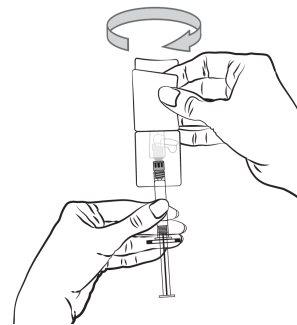
- Аккуратно потяните за чехол, чтобы отделить его от иглы, двигаясь по прямой линии. Не поворачивайте чехол, поскольку игла может ослабнуть и отделиться от шприца.
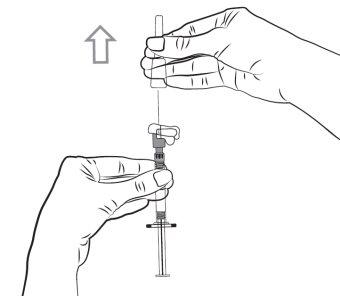
- Поместите шприц с установленной иглой в вертикальное положение для удаления воздуха. Удалите воздух из шприца, аккуратно продвигая поршень вперед.
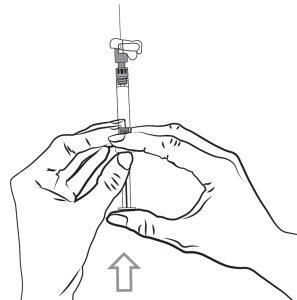
- Введение всего содержимого шприца внутримышечно, медленно и глубоко в выбранную дельтовидную или ягодичную мышцу пациента. Не вводите внутривенно или подкожно.
- После завершения инъекции используйте большой палец или другой палец руки (8а, 8б) или плоскую поверхность (8в), чтобы активировать систему защиты иглы. Система полностью активируется, когда слышен щелчок. Утилизируйте шприц с иглой должным образом.
8а
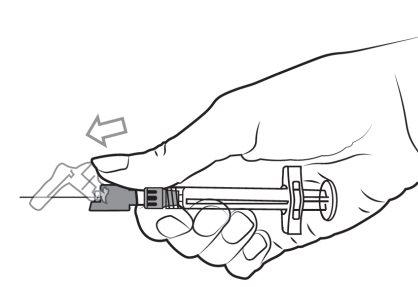
8б
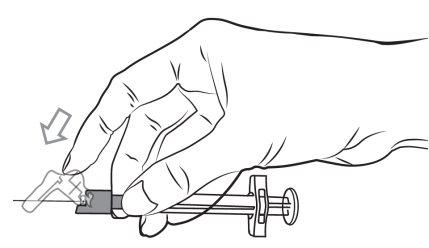
8в


Сколько стоит ПАЛЬМЕУКС 50 мг СУСПЕНЗИЯ ДЛЯ ИНЪЕКЦИЙ ПРОЛОНГИРОВАННОГО ДЕЙСТВИЯ В ПРЕДНАПОЛНЕННОМ ШПРИЦЕ в Испании в 2025 году?
Средняя цена на ПАЛЬМЕУКС 50 мг СУСПЕНЗИЯ ДЛЯ ИНЪЕКЦИЙ ПРОЛОНГИРОВАННОГО ДЕЙСТВИЯ В ПРЕДНАПОЛНЕННОМ ШПРИЦЕ в октябрь, 2025 года составляет около 104.73 евро. Финальная стоимость может зависеть от региона, конкретной аптеки и рецептурного статуса. Для точной информации лучше проверить онлайн или в ближайшей аптеке.
- Страна регистрации
- Средняя цена в аптеках104.73 EUR
- Активное вещество
- Требуется рецептДа
- Производитель
- СоставPOLISORBATO 20 (6 mg mg), HIDROGENOFOSFATO DE SODIO ANHIDRO (2,5 mg mg), DIHIDROGENOFOSFATO DE SODIO MONOHIDRATO (1,2 mg mg), HIDROXIDO DE SODIO (E 524) (7 pH mg)
- Информация носит справочный характер и не является медицинской рекомендацией. Перед приемом любых препаратов проконсультируйтесь с врачом. Oladoctor не несет ответственности за медицинские решения, принятые на основе этого контента.
- Аналоги ПАЛЬМЕУКС 50 мг СУСПЕНЗИЯ ДЛЯ ИНЪЕКЦИЙ ПРОЛОНГИРОВАННОГО ДЕЙСТВИЯ В ПРЕДНАПОЛНЕННОМ ШПРИЦЕФорма выпуска: ИНЪЕКЦИОННЫЙ РАСТВОР, 150 мг + 100 мгАктивное вещество: paliperidoneПроизводитель: Teva Pharma S.L.U.Требуется рецептФорма выпуска: ИНЪЕКЦИОННЫЙ РАСТВОР, 50 мгАктивное вещество: paliperidoneПроизводитель: Teva Pharma S.L.U.Требуется рецептФорма выпуска: ИНЪЕКЦИОННЫЙ РАСТВОР, 1000 мгАктивное вещество: paliperidoneПроизводитель: Janssen-Cilag International N.VТребуется рецепт




